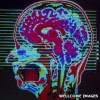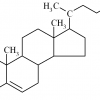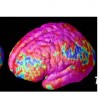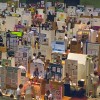Cancer Genomics: so many mutations!
 The human genome is the complete collection of over three billion bases in each of our cells. Cancers accumulate multiple changes, or mutations, in their DNA that contribute to the disease by changing how cells behave. For instance, cancers need nutrients to grow. Very often, they get these nutrients by producing signals that encourage new blood vessel formation. Finding the mutations that lead to cancer is very difficult. For one thing, even for cancers that affect the same tissue and look similar, the mutations can be very different. Also, one of the hallmarks of cancer is an increased rate of mutation. This means that cancer cells have many mutations, and most don’t contribute to the disease. For example, a lung cancer genome that was sequenced this year had nearly 23,000 mutations. Finding a mutation that contributes to cancer is like finding the right needle from a collection of needles in a haystack.
The human genome is the complete collection of over three billion bases in each of our cells. Cancers accumulate multiple changes, or mutations, in their DNA that contribute to the disease by changing how cells behave. For instance, cancers need nutrients to grow. Very often, they get these nutrients by producing signals that encourage new blood vessel formation. Finding the mutations that lead to cancer is very difficult. For one thing, even for cancers that affect the same tissue and look similar, the mutations can be very different. Also, one of the hallmarks of cancer is an increased rate of mutation. This means that cancer cells have many mutations, and most don’t contribute to the disease. For example, a lung cancer genome that was sequenced this year had nearly 23,000 mutations. Finding a mutation that contributes to cancer is like finding the right needle from a collection of needles in a haystack.
To find these driver mutations, scientists look for the ones that occur frequently. Until recently, this was very difficult to do. However, new sequencing technologies now let scientists look for mutations in genes at an incredible rate. The cost of sequencing is dropping dramatically; to the point where in the near future sequencing the DNA from a cancer may be sequenced as a diagnostic. Soon, it may be the cost of computing that limits our sequencing efforts.
Improvements in technology allow scientists to look at the genomes of many tumors, and there is an international effort to look at 25000 cancer genomes. This will provide the data that will let them find the mutations that lead to cancer, even if they occur in a small proportion of tumors of a particular kind. Already, hundreds of tumors have been studied in detail, which is giving scientists a good feel for the patterns of mutations that happen in cancer cells. So far, over 400 genes directly linked to cancer have been identified in this and other studies. Figuring out how these many genes contribute to cancer is likely to lead to huge advances in diagnosis and treatment, although the task remains gargantuan.
| Print article | This entry was posted by Bruce Nash on February 18, 2011 at 12:14 pm, and is filed under Inside Cancer. Follow any responses to this post through RSS 2.0. You can skip to the end and leave a response. Pinging is currently not allowed. |










